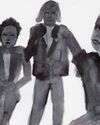As Tomas Maier, the man behind Bottega Veneta, leaves the Italian Maison, we look back at how the 61-year-old German-born design took his vision for a logo-less world into a maximalist market.

“Wait, so I’m going to be on your cover?” Tomas Maier asks. “You sure you want to do that? Your sales might go down,” he laughs. His seemingly uninterested attitude toward being put in the spotlight, or garnering any kind of attention at all is something that has, in many ways, found its way into his work at Bottega Veneta, where he has been creative director since 2001.
That was the year Tom Ford phoned Maier to ask him to consider taking up the creative reins at the Italian brand. It was a question Maier didn’t need a lot of time to answer. “The opportunity to helm the creative direction of a big fashion brand doesn’t come up every day,” he says. “I was old enough to realise that.”
He was 44 then and, at the time, was establishing his eponymous label in the United States, designing out of his studio in Florida. Most expected him to skip a season and present his first collection for Bottega Veneta the following year but Maier hit the ground running and went in guns blazing. “It took me only a few months to put out my first collection when I took over,” he recalls. “It was crazy, but it was possible because I had a very strong idea of what I wanted.”
That idea was to get rid of logos. “I didn’t want to hang around. I remember saying, ‘Let’s get this going as soon as possible,’” Maiers says. “When I joined, the brand was completely full of logos. Everything had logos on it, or names on it. Those were were the first things I wanted gone.”
Maier had introduced a line of accessories free of logos for his first collection. “It was a bold move at the time. Everyone who came around to look at the time said they were unsellable.”
この記事は T Singapore: The New York Times Style Magazine の July 2018 版に掲載されています。
7 日間の Magzter GOLD 無料トライアルを開始して、何千もの厳選されたプレミアム ストーリー、9,000 以上の雑誌や新聞にアクセスしてください。
すでに購読者です ? サインイン
この記事は T Singapore: The New York Times Style Magazine の July 2018 版に掲載されています。
7 日間の Magzter GOLD 無料トライアルを開始して、何千もの厳選されたプレミアム ストーリー、9,000 以上の雑誌や新聞にアクセスしてください。
すでに購読者です? サインイン

Look At Us
As public memorials face a public reckoning, there’s still too little thought paid to how women are represented — as bodies and as selves.

Two New Jewellery Collections Find Their Inspiration In The Human Anatomy
Two new jewellery collections find their inspiration in the human anatomy.

She For She
We speak to three women in Singapore who are trying to improve the lives of women — and all other gender identities — through their work.
Over The Rainbow
How the bright colours and lively prints created by illustrator Donald Robertson brought the latest Weekend Max Mara Flutterflies capsule collection to life.

What Is Love?
The artist Hank Willis Thomas discusses his partnership with the Japanese fashion label Sacai and the idea of fashion in the context of the art world.

The Luxury Hotel For New Mums
Singapore’s first luxury confinement facility, Kai Suites, aims to provide much more than plush beds and 24-hour infant care: It wants to help mothers with their mental and emotional wellbeing as well.

Who Gets To Eat?
As recent food movements have focused on buying local or organic, a deeper and different conversation is happening among America’s food activists: one that demands not just better meals for everyone but a dismantling of the structures that have failed to nourish us all along.

Reimagining The Future Of Fashion
What do women want from their clothes and accessories, and does luxury still have a place in this post-pandemic era? The iconic designer Alber Elbaz thinks he has the answers with his new label, AZ Factory.

A Holiday At Home
Once seen as the less exciting alternative to an exotic destination holiday, the staycation takes on new importance.
All Dressed Up, Nowhere To Go
Chinese supermodel He Sui talks about the unseen pressures of being an international star, being a trailblazer for East Asian models in the fashion world, and why, at the end of the day, she is content with being known as just a regular girl from Wenzhou.